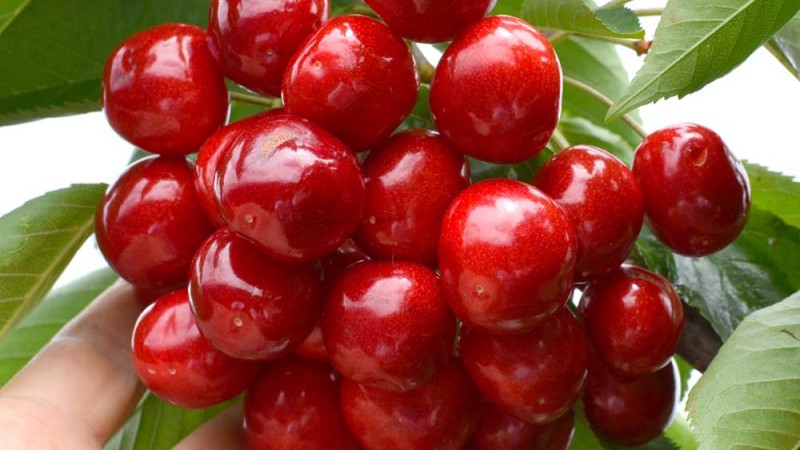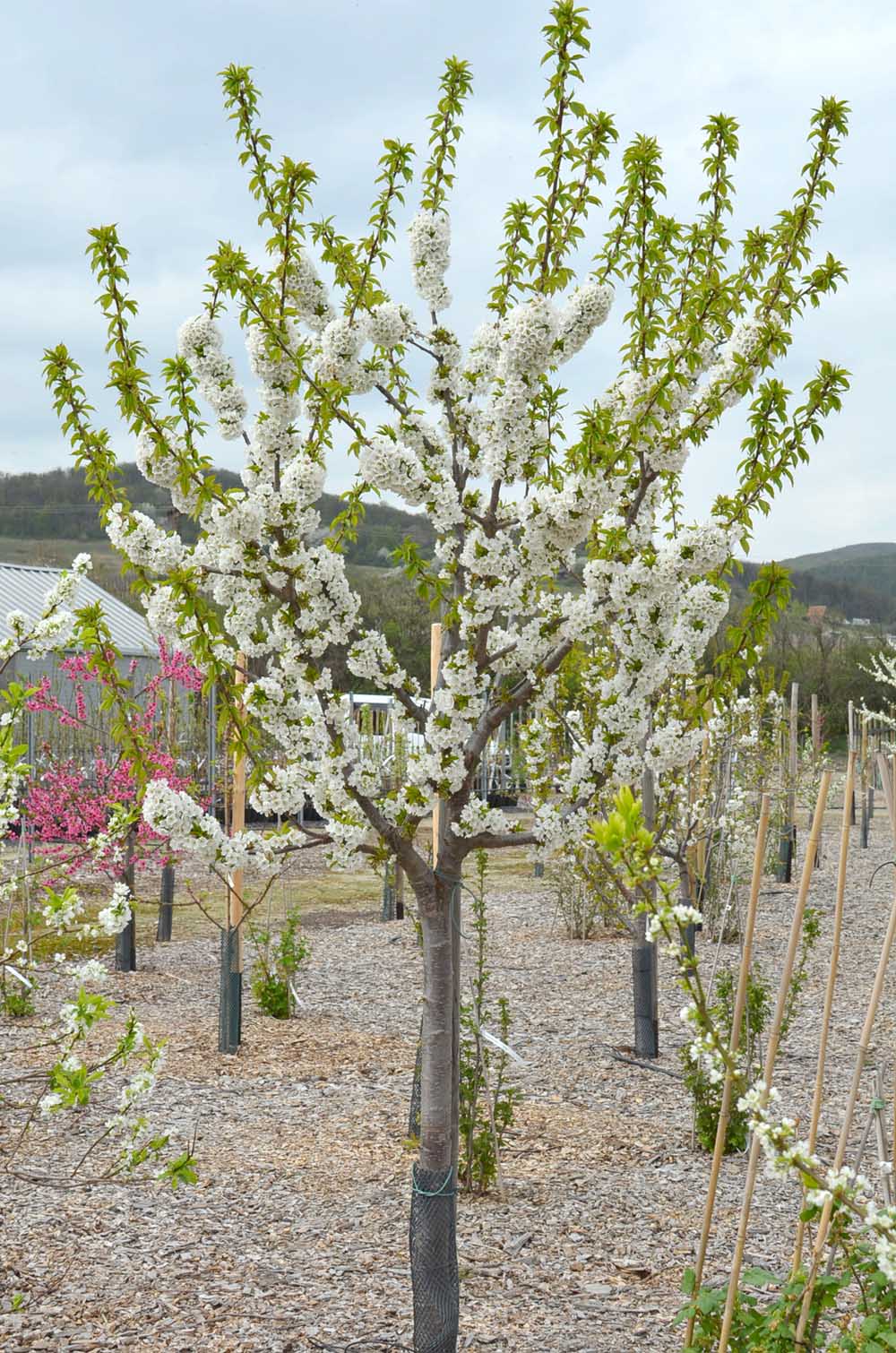

That is good news for all cherry lovers with a small garden. This is thanks to a team of German breeders from the Institute of Plant Production and Plant Breeding at the University of Giessen, who have developed the GiSelA cherry rootstock series. These rootstocks reduce the growth of the grafted variety so that the tree reaches only a fraction of the size of a cherry grafted onto a cherry seedling and is easy to care for. The most widely used rootstock from this series is the GiSelA 5 semi-dwarfing rootstock. It is compatible with all current cherry varieties and the great advantage is that varieties grafted on the GiSelA rootstock flower and bear fruit in the second year after planting. In the fourth year after planting, you can expect a harvest of around 5 kg of cherries. A cherry tree grafted onto a cherry seedling begins to bear fruit much later, and will not produce significant yields until the age of 6 to 10 years.
Cherry trees thrive in various types of soil, except heavy and waterlogged ones. The tree needs a sunny and airy location. Cherry flowers are sensitive to frost, so avoid areas with frequent late frosts. A cherry tree on GiSelA 5 rootstock requires a minimum space of 10 m² (which corresponds to a canopy diameter of about 3 m). To ensure sufficient water supply for the young tree, keep the soil under the canopy free of weeds and always irrigate during dry periods in the first year. Depending on the quality of the soil, apply 30g of complete (NPK ) fertilizer per m² annually at the beginning of bud break and the same amount again after flowering. The fertilizer should be spread over the entire area under the tree canopy.
Cherry Pruning on GiSelA 5 Rootstock
Pruning Time - Cherries can be pruned from bud swelling until 2 months after harvest. Strongly growing trees are best pruned after harvest, because pruning at this time can reduce the growth force of the cherry. Spring pruning, on the other hand, promotes growth force. If the cherry grows in an area with frequent occurrence of gummosis, pruning should only take place at times with a low risk of infection, i.e. in summer, during the warm dry period.
Training - Tree care in the first years after planting, known as training, determines its future crown shape. For cherries on GiSelA 5 rootstocks, the training phase, during which the tree does not yet bear fruit fully, lasts only 2-4 years. There are many different training methods. One of them, which is easy for a layman to follow, is schematically described here. This is crown training in the shape of a more or less wide cone with a central axis and weaker side branches growing from it.
In the first growing season - Start treating the tree in the following spring if planted in the fall, and immediately after planting if planted in the spring. The 5-6 buds located directly below the apical bud are broken off along the central axis when the buds swell. The next lower bud will become a lateral shoot the following year, and the apical bud will extend the trunk. Below that, select 3 to 5 shoots extending from the trunk that are well spaced vertically and laterally; these shoots will later form the fruiting branches. They must not be too close together to ensure good light and air circulation in all parts of the crown.
In the second and third growing seasons - In summer the newly grown side shoots in the upper part of the crown are pinched after the 4th to 6th leaf. Long, unbranched side shoots in the middle and lower parts of the crown are shortened to encourage branching. Care should be taken to maintain the conical shape of the crown. Diseased, overly dense, inward-facing, or crosswise branches should be pruned at the branch point (i.e., at the point where they branch off from the parent wood).
From the 4th or 5th growing season onwards - regular pruning. In the 4th or 5th year, the tree structure is established and the tree enters the full production phase. Now, growth must be encouraged through annual pruning to ensure high yields and good fruit quality for many years. If trees on GiSelA 5 are not pruned regularly, bare branches and excessive fruit set with relatively small fruits can occur. Pruning also maintains good light and air circulation in the crown and limits the tree's height and lateral expansion.
Maintenance pruning keeps trees healthy
Maintenance pruning should be started when the growth of the previous year's shoots is less than 30 cm. Here are the basic rules:
• remove diseased, dead and weak shoots
• the main lateral branches should be shortened by an average of 1/3 of their length, the upper ones more and the lower ones less. This is done to maintain the conical shape of the crown, which is most suitable for optimal light penetration of the entire crown, including the lower part.
• if the lateral branch is pointing downwards, try to get it back to a horizontal position by cutting it back. Proceed by cutting the branch down to the next lateral, upward-pointing shoot.
• if the tree has reached the maximum height you want, cut the top down to the next weaker lateral shoot. The best time is after harvest. This procedure can be repeated in subsequent years. Because the tree grows on the GiSelA 5 rootstock, it does not respond to this procedure by forming strong shoots in the top part. Therefore, it can be maintained at a maximum and stable height of 3.5 m.
• occasionally, i.e. not every year, cut off one of the lateral fruit-bearing shoots completely, up to the main axis. The amount of light in the crown will awaken the formation of a new lateral shoot with a rich fruit-bearing growth.
• another recommendation is to cut back weakly growing annual shoots down to the old wood, in accordance with the rule: the weaker the growth, the stronger the cut









